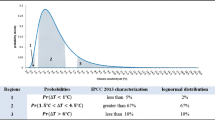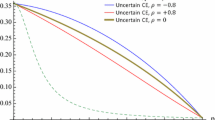Abstract
This paper explores optimal near-term technology R&D in the face of uncertain damages caused by the buildup of greenhouse gases. The paper puts particular emphasis on understanding how optimal near-term R&D expenditures might vary based on the technologies pursued in the R&D program. The exploration is conducted in the context of varying impacts from R&D on the global abatement cost function. The R&D planning problem is considered first within a theoretical framework and is then pursued in a stylized application using the DICE model. The paper provides intuition into the circumstances under which near-term technology R&D might increase or decrease under uncertainty, thereby serving as a hedge against climate uncertainty.
Similar content being viewed by others
References
Athey, S.: 2000. Comparative Statics in Stochastic Problems with Applications. PhD Thesis Graduate School of Business, Stanford University, Palo Alto.
Baker, E.: 2002. Increasing Informativenss and Increasing Risk: Equivalence Theorems, PhD Thesis Department of Management Science and Engineering, Stanford University, Palo Alto.
Baker, E.: 2005. “Uncertainty and Learning in a Strategic Environment: Global Climate Change.” Resource and Energy Economics 27, 19–40.
Baker, E. & Shittu, E.: Forthcoming, “Profit-Maximizing R&D in Response to a Random Carbon Tax.” Resource and Energy Economics (See: http://www.ecs.umass.edu/mie/faculty/baker.html).
Baker, E., Clarke, L. & Weyant, J.: 2003. “R&D as a Hedge Against Climate Damages.” University of Massachusetts, Amherst.
Baudry, M.: 2000. “Joint Management of Emission Abatement and Technological Innovation for Stock Externalities.” Environmental and Resource Economics 16, 161–183.
Buonanno, P., Carraro, C. & Galeott, M.: 2003. “Endogenous Induced Technical Change and the Costs of Kyoto.” Resource and Energy Economics 25, 11–34.
Clarke, L. & Weyant, J.: 2002. Modeling Induced Technological Change: An Overview. In Technological Change and the Environment, ed. A. Grubler, N. Nakicenovic and W. Nordhaus. Resources for the Future.
Farzin, Y. H. & Kort, P.M.: 2000. “Pollution Abatement Investment When Environmental Regulation is Uncertain.” Journal of Public Economic Theory 2, 183–212.
Gollier, C., Bruno, J. & Treich, N.: 2000. “Scientific Progress and Irreversibility: An Economic Interpretation of the ‘Precautionary Pricipal.’” Journal of Public Economics 75, 229–253.
Goulder, L. & Mathai, K.: 2000. “Optimal CO 2 Abatement in the Presence of Induced Technological Change.” Journal of Environmental Economics and Management 39(1), 1–38.
Goulder, L. & Schneider, S.: 1999. “Induced Technological Change and the Attractiveness of CO 2 Abatement Policies.” Resource and Energy Economics 21, 211–253.
Goulder, L.H., Parry, I., Williams, R.C. & Butraw, D.: 1999. “The Cost-Effectiveness of Alternative Instruments for Environmental Protection in a Second-Best Setting.” Journal of Public Economics 72, 329–360.
Jaffe, A., Newell, R. & Stavins, R.: 2003. Technological Change and the Environment. In Handbook of Environmental Economics. Vol. 1 Elsevier Science.
Keller, K., Bolker, B. & Bradford, D.: 2004. “Uncertain Climate Thresholds and Optimal Economic Growth.” Journal of Environmental Economics and Management 48, 723–741.
Kimball, M. S.: 1990. “Precautionary Savings in the Small and in the Large.” Econometrica 58, 53–73.
Kolstad, C.: 1996. “Learning and Stock Effects in Environmental Regulation: the Case of Greenhouse Gas Emissions.” Journal of Environmental Economics and Management 31, 1–18.
Manne, A. & Richels, R.: 2002. The Impact of Learning-by-Doing on the Timing and Cost of CO 2 Abatement. Technical Report Working Paper AEI-Brookings Joint Center for Regulatory Studies.
Manne, Alan S.: 1996. “Hedging Strategies for Global Carbon Dioxide Abatement: A Summary of Poll Results – EMF 14 Subgroup Analysis for Decisions Under Uncertainty.” Energy Modeling Forum, Stanford University.
Newell, R.: 1997. Environmental Policy and Technological Change: the Effects of Economic Incentives and Direct Regulation on Energy-Saving Regulation, Ph.d. Thesis Harvard University.
Newell, R., Jaffe, A. & Stavins, R.: 1999. “The Induced Innovation Hypothesis and Energy-Saving Technological Change.” Quarterly Journal of Economics 114(3), 941–975.
Nordhaus, W. D.: 1994. “Expert Opinion on Climatic Change.” American Scientist 82, 45–51.
Nordhaus, W. D.: 2002. Modeling Induced Innovation in Climate Change Policy. In Technological Change and the Environment, ed. Arnulf Grubler, Nebojsa Nakicenovic and William D. Nordhaus. Washington D.C. and Laxenburg, Austria: RFF and IIASA pp. 182–209.
Nordhaus, W. D. & Joseph Boyer.: 2000. Warming the World: Economic Models of Global Warming. Cambridge, MA: MIT Press.
Pizer, W.: 1999. “The Optimal Choice of Climate Change Policy in the Presence of Uncertainty.” Resource and Energy Economics 21(3/4), 255–287.
Popp, D.: 2004. “ENTICE: Endognenous Technological Change in the DICE Model of Global Warming.” Journal of Environmental Economics and Management 48, 742–768.
Rothschild, M. & Stiglitz, J.: 1970. “Increasing Risk I: A Definition.” Journal of Economic Theory 2, 225–243.
Rothschild, M. & Stiglitz, J.: 1971. “Increasing Risk II: Its Economic Consequences.” Journal of Economic Theory 3, 66–84.
Schneider, S. & Goulder, L.: 1997. “Achieving Low-Cost Emissions Targets.” Nature 389(4), 13–14.
Smith, J. E.: 1993. “Moment Methods for Decision Analysis.” Management Science 39, 340–358.
Sue Wing, I.: 2003. Induced Technical Change and the Cost of Climate Policy. Technical Report 102 MIT Joint Program on the Science and Policy of Global Change.
Ulph, A. & Ulph, D.: 1997. “Global Warming, Irreversibility and Learning.” The Economic Journal 107, 636–650.
van der Zwaan, B.C.C., Gerlagh, R., Klaassen, G. & Schrattenholzer, L.: 2002. “Endogenous Technological Change in Climate Change Modeling.” Energy Economics 24, 1–19.
Webster, M.: 2002. “The Curious Role of “Learning” in Climate Policy: Should we Wait for More Data?” Energy Journal 23(2), 97–119.
Author information
Authors and Affiliations
Corresponding author
Rights and permissions
About this article
Cite this article
Baker, E., Clarke, L. & Weyant, J. Optimal Technology R&D in the Face of Climate Uncertainty. Climatic Change 78, 157–179 (2006). https://doi.org/10.1007/s10584-006-9092-8
Received:
Accepted:
Published:
Issue Date:
DOI: https://doi.org/10.1007/s10584-006-9092-8




